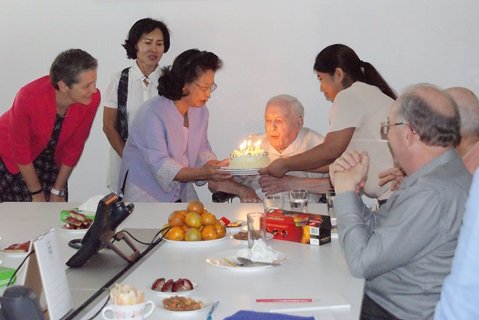Life Stories
Thomas Barns
Thomas Barns (1939 BA Physiological Science) died in September 2023 aged 104.

Dr Barns celebrating his 100th birthday with colleagues at the WHO Office in Thailand, in 2019. Credit: WHO
Thomas Everard Christopher Barns was born at the Gatehouse of Highclere Castle—better known today as Downton Abbey—in 1919.
Tom was raised in a strict Anglo-Catholic tradition in Ealing and Kensington. He entered Keble College in 1939 to study Physiological Sciences and was also a successful oarsman.
After qualifying as a doctor, Tom was drafted into the Army Medical Corps, stationed near Catterick. In 1944, he attended a performance of Bach’s St Matthew Passion at York Minster with his mother. By chance, he reconnected there with Dr Fitch—whom he had once met on a bus—and was introduced to his daughter, Teresa. Teresa became, in family lore, “Tom’s York Minster pick-up.” They married within seven weeks.
Tom’s posting to India and the Burma Campaign profoundly reshaped his worldview. As the troop ship docked, he was struck by the vivid colours and light, the stench of open drains, the intoxicating scent of flowers, and the confronting poverty and disfigurements of beggars. After only a few weeks of training, he qualified as an anaesthetist and was posted to a Mobile Surgical Unit on the Arakan front in Myanmar—precursors to the units later popularized in MASH*. These units operated as close to the front lines as possible, moving from battle to battle along the Arakan coast, through burnt villages, ruined temples, and harrowing loss of life.
Following demobilization, Tom resumed medical training under his mentor, Dr John Stallworthy. At the time, maternal and infant mortality in home births was a pressing issue. Dr Stallworthy, along with Professor Chassar Moir CBE, was developing an emergency maternity service, which relied on doctors arriving quickly to patients’ homes in fast cars.
Tom and his family later moved to Winchester, and then to Newcastle, where he completed a PhD. His research involved mapping deaths from pelvic tuberculosis using small black crosses over maps of impoverished housing. This work earned him the prestigious Blair Bell Lecture at the Royal College of Obstetricians and Gynaecologists in 1954.
A lifelong dreamer and adventurer, Tom often pored over the job pages in The Lancet, devising plans to work in remote places such as the Outer Hebrides, Fiji, Ethiopia, Nepal, and beyond—envisioning journeys through game reserves, mountains, deserts, and forgotten cities.
From Newcastle, the family relocated to Johor Bahru in Malaysia, where Tom became State Obstetrician to the Sultan of Johore. As he put it, “Who could resist that?”
During the next three years, he established his first Emergency Maternity Service in rural villages, personally delivering care 24/7 in a specially equipped jeep—even while the region was in turmoil during the Malayan Emergency. Remarkably, this system is still reportedly in use today.
Next, Tom was appointed Consultant Gynaecologist for West Cumberland. Over the next decade, he developed the most modern maternity unit in Britain at the time, part of the first general hospital built after WWII. It went, as he admitted, “way over budget”.
His journey then led him to the Christian Medical College in Vellore, South India—a place he had discovered and vowed to return to during the war. He went on to research rural maternal and child health systems in the Punjab in partnership with Johns Hopkins University. As Regional Adviser for the World Health Organization (WHO), he promoted nationwide healthcare systems in the Philippines, Indonesia, Sri Lanka, the Maldives, and Mongolia.
Even after retiring, Tom continued to work internationally, primarily in the Middle East—until, as he put it, “no one would employ me any longer”.
In their 90th year, Tom and Teresa moved to Bangkok, assuring each other, “We won’t be long, dear, just three or four years.” But, ever the poor planners—and thanks to loving Thai and Malay care—they lasted for fourteen.
Kindly provided by his family
